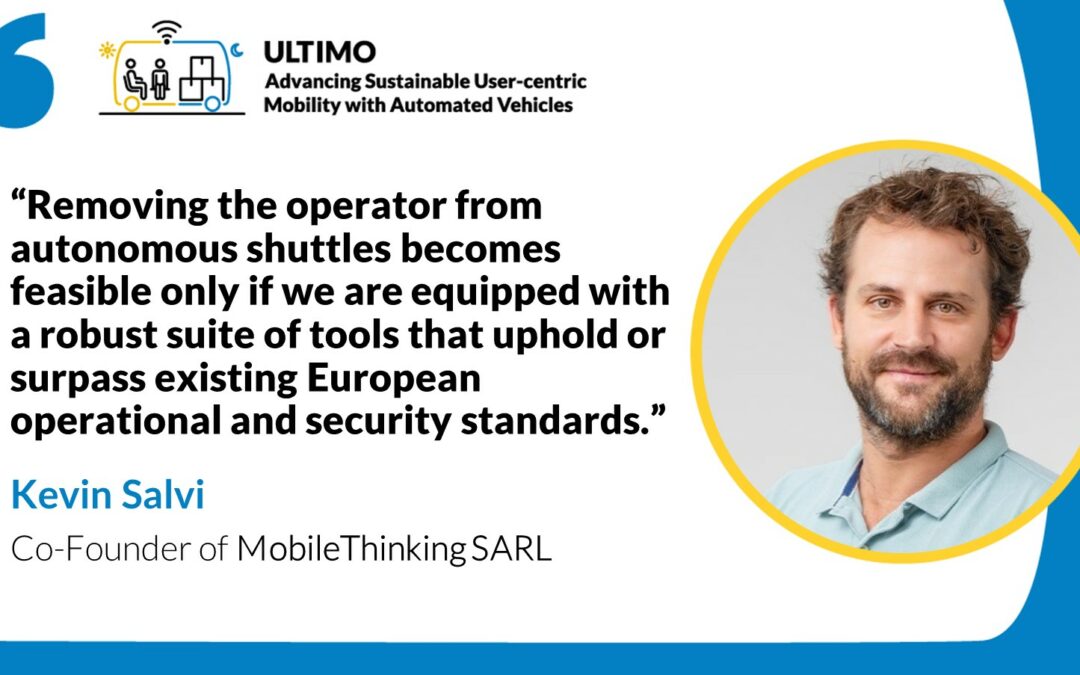Within ULTIMO, MobileThinking is responsible for the Supervision Dashboard. Can you explain a bit more about this?
MobileThinking’s Supervision Dashboard is a comprehensive platform developed for the ULTIMO project to enable Public Transport Operators (PTOs) to monitor and manage autonomous vehicle fleets effectively. The PTO should guarantee the same level of passenger service as with transport with drivers. Since the vehicles do not have drivers nor any PTO personnel onboard, remote monitoring is paramount. This tool provides real-time insights into vehicle operations, ensuring safety, efficiency, and regulatory compliance. Integrated with our Intervention Application, the dashboard facilitates swift responses to any operational issues or emergencies, allowing PTOs to dispatch intervention teams directly to the site when needed, thereby enhancing overall service reliability and safety.
Within ULTIMO, can you tell us a bit more about the sensors inside the vehicle and the data they extract?
An advanced sensor ecosystem is pivotal in the ULTIMO project’s autonomous vehicles. While we focus on cameras and environmental sensors, the intelligence of the overall ULTIMO system significantly lies in the sophisticated algorithms processing camera data provided by our partner CERTH:
- Cameras: The cameras play a crucial role in ensuring passenger safety and operational security. ULTIMO’s algorithms enable the detection of various incidents within the vehicle, such as falls, abandoned luggage, and fights, triggering immediate alerts on the Supervision Dashboard. This allows for rapid assessment and response, enhancing passenger safety and security.
- Environmental Sensors: These sensors monitor the vehicle’s internal atmosphere, tracking parameters like temperature, CO2 levels, smoke, and humidity. This data ensures a comfortable and safe environment for passengers, alerting operators to any conditions that require attention.
This sensor array, especially the intelligent camera system, is integral to maintaining high safety standards and operational efficiency in autonomous public transportation.
Within ULTIMO, how does the developed function increase safety in the vehicle?
The services within the Supervision Dashboard enhances safety by providing a rapid and informed response system for incidents and accidents involving automated shuttles. It replaces the traditional driver’s role in emergency communication, using sensors and AI to relay critical accident details to the PTO’s fleet supervisor and intervention teams in real-time.
Key features include:
- Rapid Detection and Communication: Immediate identification and notification of in-vehicle incidents, external accidents, or road collisions, facilitating swift response actions.
- Targeted Intervention: By specifying the accident’s nature and location, the system ensures the deployment of the most appropriate intervention team, equipped with the necessary information to effectively manage the situation.
- Incident Logging for Continuous Improvement: The service diligently logs every incident, offering critical data that aids in developing insights crucial for informing future safety regulations and legislation concerning autonomous vehicle operations.
This service streamlines the coordination between the PTO’s supervision center and intervention teams, significantly improving the overall safety and response efficiency in the event of an accident.
Within ULTIMO, do you see any challenges in your task (or maybe you have already encountered them) and how would you tackle them?
Developing the Supervision Dashboard, we encounter several challenges like:
- Complex Integration: The service requires integrating various technologies, including sensors, AI, and communication systems, into a cohesive platform with high security requirements. To address this, we focus on modular design principles, allowing for seamless integration and scalability.
- Data Privacy and Security: Utilizing cameras and sensors raises concerns about passenger privacy. We mitigate this by implementing strict data protection protocols, anonymizing data where possible, and ensuring compliance with relevant privacy regulations.
- Real-Time Data Processing: The need for immediate accident detection and response demands robust real-time data processing capabilities. We tackle this by employing advanced algorithms and ensuring our infrastructure can handle the rapid analysis and dissemination of information.
- Collaboration Between Partners: Ensuring effective collaboration among all consortium members, each with their expertise and priorities, is crucial. We facilitate this through regular communication, joint problem-solving sessions, and shared goals to align our efforts towards the project’s success.
- Adapting to Various Accident Scenarios: The service must effectively handle diverse accident types and scenarios. We address this by continuously updating and testing our systems against a wide range of potential incidents, ensuring our responses are comprehensive and adaptable.
By proactively addressing these challenges, we aim to enhance the reliability and effectiveness of the ecosystem, contributing to the overall safety and success of the ULTIMO project.
Get to know all our members: https://ultimo-he.eu/our-members/

